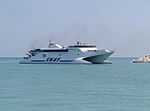High-speed craft
.JPG)



A high-speed craft (HSC) is a high speed water vessel for civilian use, also called a fastcraft or fast ferry. The first high-speed craft were often hydrofoils or hovercraft, but in the 1990s catamaran and even monohull designs have become popular. Most high-speed craft serve as passenger ferries, but the largest catamarans and monohulls also carry cars and even buses and freight (e.g. Stena's HSS). Hulled designs are often powered by pump-jets coupled to medium speed diesel engines. Hovercraft are usually powered by gas turbines or diesel engines driving propellors and impellors.
The design and safety of high-speed craft is regulated by the High Speed Craft Codes of 1994 and 2000, adopted by the Maritime Safety Committee of the International Maritime Organisation (IMO).
In accordance with SOLAS Chapter X Reg. 1.3, High Speed Crafts are crafts capable of a maximum speed, in metres per second (m/s), equal to or exceeding:

where:  = volume of displacement in cubic metres corresponding to the design waterline, excluding craft of which the hull is supported clear above the water surface in non-displacement mode by aerodynamic forces generated by ground effect.
= volume of displacement in cubic metres corresponding to the design waterline, excluding craft of which the hull is supported clear above the water surface in non-displacement mode by aerodynamic forces generated by ground effect.
HSC Examples
- HSC Benchijigua Express world´s largest civilian trimaran.
- Fincantieri MDV1200 Super SeaCat
- PacifiCat Series
- Auto Express 86
- Passenger-Only Fast Ferry Class ferry
- Meteor (hydrofoil)
- High-speed Sea Service, Finnyards HSS 1500 and Westamarin HSS 900 developed and operated by Stena Line
- Hawaii Superferry
- Lake Express (Lake Michigan)
- Leonora Christina
- HSC Silvia Ana L
- Tanger Jet II
- Tarifa Jet
- HSV-2 Swift
- HMAS Jervis Bay (AKR 45)
- SSTH Ocean Arrow
- Villum Clausen
- HSC Jonathan Swift
See also
External links
